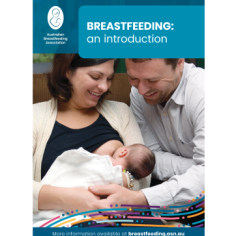There are many breastfeeding positions and no one best way to hold your baby for breastfeeds.

Some mums use a range of breastfeeding positions, while others find a favourite and use it often. No matter which position you use, you can help your baby to attach and feed well by positioning them so they are close to you and can take a good mouthful of your breast.
Your baby has natural instincts which enable them to find your breast from birth with little or no help from anyone. These instinctive behaviours include:
sticking their tongue out
turning their head from side to side
wriggling
finding and grasping the nipple
attaching to the breast
suckling
You may choose to let your baby find their own way to your breast using these instincts. This is called baby-led attachment. Many mums use this method while lying in a reclining position.
You can also choose to position your baby in the way that suits you and to help your baby to attach. Sometimes we call this mother-led attachment.
Options for mother-led attachment
There are a number of ways that you might choose to hold your baby to feed:
- cradle hold
- cross-cradle hold
- underarm / football or twin hold
- laid-back / semi-reclined
- straddle hold
- side-lying
Try a few and see which you and your baby find the most comfortable.
Cradle hold
This position is the most widely used. Your baby’s head is at the level of your breast and their body is wrapped around your chest. Their legs are tucked in to avoid falling away.

Cross cradle hold
This position is useful if you want to use your hand to shape your breast so your baby can take a bigger mouthful of your breast. Hold your baby to your chest and support their neck and shoulders with the arm opposite to the breast your baby is attaching to. Once your baby is attached and sucking, you can swap arms to adopt the traditional cradle hold which is more comfortable for a long feed.
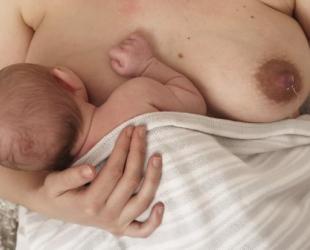
Laid-back or semi-reclined
In this position, you lean back, usually supported with cushions or pillows with your baby on your chest. This position is relaxing because your baby’s weight is on your chest and holding baby is easier. Hold your baby in this way for baby-led attachment.
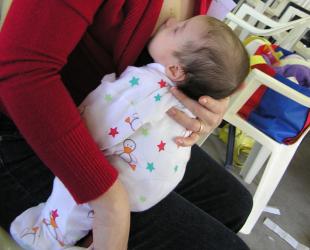
Straddle hold
You may need to hold your baby in a more upright position, either with them sitting on your lap or with their legs either side of your leg. Some babies prefer to be held upright or can't lie on their side to feed. It is also useful if you have a fast-flow (especially if you can recline a bit) or have an older baby who likes to look around.
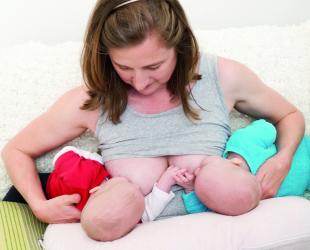
Underarm / Football / Twin hold
In this position, your baby’s head faces inwards and their legs are tucked around under your arm towards your back. This position is helpful if you’ve had a caesarean as it avoids your baby pressing on your stomach. Of course, it’s useful for feeding twins at the same time! Pillows can be helpful in this position.
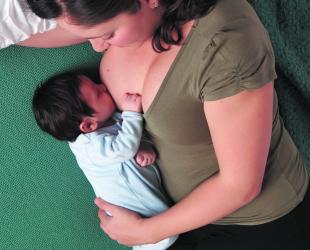
Lying down
This position can take some practice and may be easier once your baby is a little older and can attach themselves to your breast. You will need to make sure that your baby remains very close to your body so they can keep their attachment.
Steps to attach your baby
Whichever position you choose, you need to be comfortable with your back and feet supported (except if you're lying down).
Unwrap your baby and hold them close so that their chest is touching your chest. Babies are easier to position if their arms are free and they aren’t enclosed in tight wrappings. However, if your baby is very fidgety or their hands are hitting your sore nipples, you can try using a light wrapping.
Your baby’s head, shoulders and back should be in a straight line and facing your body. Their head will be at the same level as your breast with their mouth and nose level with your nipple. Their body can be lower than their head, often tucked under your other breast.
Allow your baby time to display feeding cues and open their mouth. If you bring your baby to your breast and touch or gently brush their lips with your nipple or lower side of your areola, this can encourage them to open their mouth wide.
When your baby opens their mouth wide their tongue will be down and forward. Aim your nipple at the roof of your baby’s mouth. This encourages your baby to draw your nipple in and far enough back into their mouth.
Your baby's lower jaw or chin should touch your breast first, on your areola, well down from your nipple.
As your baby's mouth closes over your breast, they should take in a large mouthful.
When your baby attaches and begins to suck, try to relax your shoulders to help your let-down reflex and to keep yourself comfortable. Move your hands, wrists and arms to be in a more relaxed position, if necessary, as long as your baby remains closely tucked into your body.
Do pillows help or not?
Pillows can work for some mums but make it harder for others to position their baby well. There are a few things to check if you use a pillow:
Be careful that the pillow puts baby at the level of your breast or just under it – not too high and not too low or you may end up leaning over.
Continue to hold your baby with your arms (or resting on your body) rather than on the pillow. If your baby is lying directly on the pillow, it can be difficult to keep them close enough. Baby needs to remain chest to chest with you, not lying back on the pillow with their head on the side.
If you like using a pillow under your forearms to help you hold your baby, you could try using a more laid-back position so your body takes more of your baby's weight rather than your arms.
Positioning - a video from Global Health Media
Watch another video showing mothers holding their babies in different positions.
Links to more videos about positioning
Laid-back breastfeeding – Suzanne Colson
Can a change in position help relieve nipple pain? - Nancy Mohrbacher
What feeding positions work if I'm large breasted? - Dr Theresa Nesbitt and Nancy Mohrbacher
How can gravity, gaps & gaze simplify early breastfeeding? - Dr Theresa Nesbitt
What adjustments make early breastfeeding easier? - Dr Theresa Nesbitt and Nancy Mohrbacher
© Australian Breastfeeding Association April 2022
Learn more about getting breastfeeding started
Online interactive session free for Virtual Village members
Newborn Virtual Village - Comfortable attachment

Evidence-led info and practical tips from our Breastfeeding Information Series
Breastfeeding: an introduction
